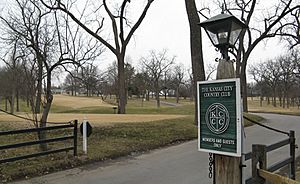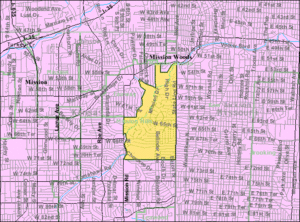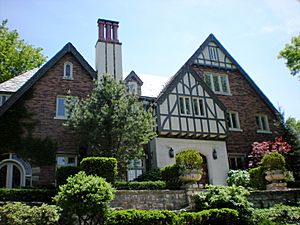Mission Hills, Kansas facts for kids
Quick facts for kids
Mission Hills, Kansas
|
|
|---|---|
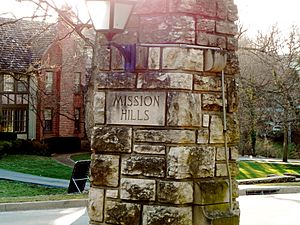
City Sign at corner of 56th Street and State Line Road
|
|
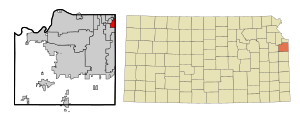
Location within Johnson County and Kansas
|
|
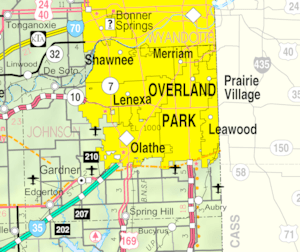
|
|
| Country | United States |
| State | Kansas |
| County | Johnson |
| Incorporated | 1949 |
| Area | |
| • Total | 2.04 sq mi (5.28 km2) |
| • Land | 2.04 sq mi (5.28 km2) |
| • Water | 0.00 sq mi (0.00 km2) |
| Elevation | 958 ft (292 m) |
| Population
(2020)
|
|
| • Total | 3,594 |
| • Density | 1,762/sq mi (680.7/km2) |
| Time zone | UTC-6 (CST) |
| • Summer (DST) | UTC-5 (CDT) |
| ZIP code |
66208
|
| Area code | 913 |
| FIPS code | 20-47350 |
| GNIS ID | 485624 |
Mission Hills is a city in Johnson County, Kansas, United States. It is part of the larger Kansas City Metropolitan Area. In 2020, about 3,594 people lived here. The eastern edge of the city is the border between Kansas and Missouri, along State Line Road.
A famous developer from Kansas City, J. C. Nichols, started building Mission Hills in the 1920s. It was part of his big plan called the Country Club District.
Contents
A Look Back in Time
The name "Mission Hills" comes from an old Indian mission. This mission was set up in the area way back in the 1830s.
The city began as a special, planned neighborhood. It was designed for people who wanted to live in a fancy area. J.C. Nichols planned it around the Mission Hills Country Club (Kansas). This club was on the hills near Brush Creek, just south of the Shawnee Methodist Mission.
Nichols wanted to make his properties in Kansas more valuable. He noticed that people who wanted to buy expensive homes didn't want to live on the Kansas side of the state line. So, he planned the country club to attract them.
He also started the Community Golf Club next to the Mission Hills Country Club. This club grew very quickly. It later moved and became what is now the Kansas City Country Club. The Community Golf Club then went on to create the Indian Hills Country Club. These three clubs became some of the most respected in the Kansas City area.
How the City Grew
Nichols didn't want Mission Hills to become an official city at first. He thought a city government might not manage things well. He also worried they might not keep up the special rules for homes. So, in 1914, the Mission Hills Home Company was created instead. This company made sure the neighborhood stayed fancy. For example, they once stopped a family from putting glass on their porch.
However, nearby towns started to grow. These towns wanted to add Mission Hills to their area because of its wealthy residents and tax money. To stop this from happening, Mission Hills officially became a city in 1949.
Many of the first homes in Mission Hills were designed by famous architects. These included Clarence E. Shepherd, Edward Tanner, and Edward Buehler Delk.
The city has a very special landmark. It's called the Verona columns and a reflecting pool. You can find them where Ensley Lane, Mission Drive, and Overhill Road meet. A landscape architect named S. Herbert Hare designed them in 1924. This landmark is even used on the city's official seal!
Famous Visitors
In 1928, the famous writer Ernest Hemingway and his wife, Pauline, stayed in Mission Hills. They lived at a house on Indian Lane. During this time, Hemingway was writing his famous book, A Farewell to Arms. He later gave a special signed copy of the book to a Kansas City doctor. The doctor had helped deliver his son, Patrick.
Hemingway and his wife came back to Mission Hills in 1931. He was working on another book then, called Death in the Afternoon.
Where is Mission Hills?
The United States Census Bureau says that Mission Hills covers about 2.02 square miles (5.23 square kilometers) of land. There is no water within the city limits, but Brush Creek flows through the northern part of the city.
The northern part of Mission Hills, north of 63rd Street, is sometimes called "old Mission Hills." This area has very large, fancy houses on big pieces of land. It also has two private country clubs: the Mission Hills Country Club and the Kansas City Country Club.
The southern part of the city includes areas like Belinder Hills, Indian Hills, and Sagamore Hills. These areas have nice homes for people who are well-off. The private Indian Hills Country Club is also located here.
People and Community
| Historical population | |||
|---|---|---|---|
| Census | Pop. | %± | |
| 1950 | 1,275 | — | |
| 1960 | 3,621 | 184.0% | |
| 1970 | 4,198 | 15.9% | |
| 1980 | 3,904 | −7.0% | |
| 1990 | 3,446 | −11.7% | |
| 2000 | 3,593 | 4.3% | |
| 2010 | 3,498 | −2.6% | |
| 2020 | 3,594 | 2.7% | |
| U.S. Decennial Census | |||
Mission Hills is known for being a very wealthy community. Forbes Magazine once ranked it as the 3rd wealthiest city in the entire country. It has the highest average household income of any city in Kansas with over 1,000 people. It is also one of the highest in the United States.
How Many People Live Here?
The 2020 United States census counted 3,594 people living in Mission Hills. There were 1,241 households, which are groups of people living together. Most of the people (about 91%) were White. About 3% were Asian, and about 5% were from two or more races. About 2.7% of the population was Hispanic or Latino.
In the households, about 40% had children under 18 years old. Most households (82%) were married couples living together. About 11% had a female head of the house without a partner. The average household had 2.7 people.
The average age of people in Mission Hills was 45 years old. About 26% of the people were under 18. About 21% were 65 years or older.
Schools and Learning
Mission Hills is part of the Shawnee Mission public school district. Many families send their children to these public schools. Some families also choose to send their children to private schools. These include schools like the Pembroke Hill School and The Barstow School. There are also religious schools like Bishop Miege High School and Rockhurst High School.
Libraries
The Johnson County Library helps all the people who live in Mission Hills.
Mission Hills in Media
Mission Hills has even been featured on TV! The ABC Family show Switched at Birth is set in Kansas City, Missouri. But the main characters on the show live in Mission Hills.
Famous People from Mission Hills
Many well-known people have lived in or were born in Mission Hills. Here are a few:
- Henry W. Bloch (1922-2019), who helped start H&R Block.
- George Brett (1953- ), a famous baseball player in the Baseball Hall of Fame.
- Marcelo Claure (1970- ), a leader in the telecommunications world.
- James Ellroy (1948- ), a well-known writer.
- Thomas Frank (1965- ), a historian and journalist.
- Matt Gogel (1971- ), a professional golfer and sportscaster.
- Donald J. Hall, Sr. (1929- ), an executive in the greeting card business.
- Kevin Harlan (1960- ), a sportscaster.
- Ewing Kauffman (1916-1993), who started a pharmaceutical company.
- Tom Watson (1949- ), another famous professional golfer.
Images for kids
See also
 In Spanish: Mission Hills (Kansas) para niños
In Spanish: Mission Hills (Kansas) para niños


